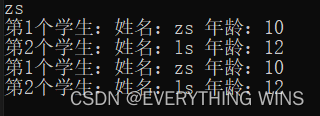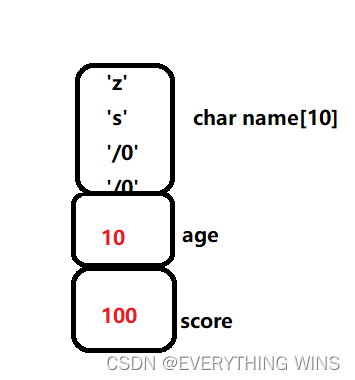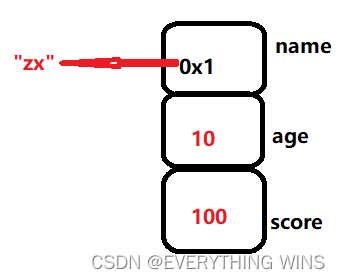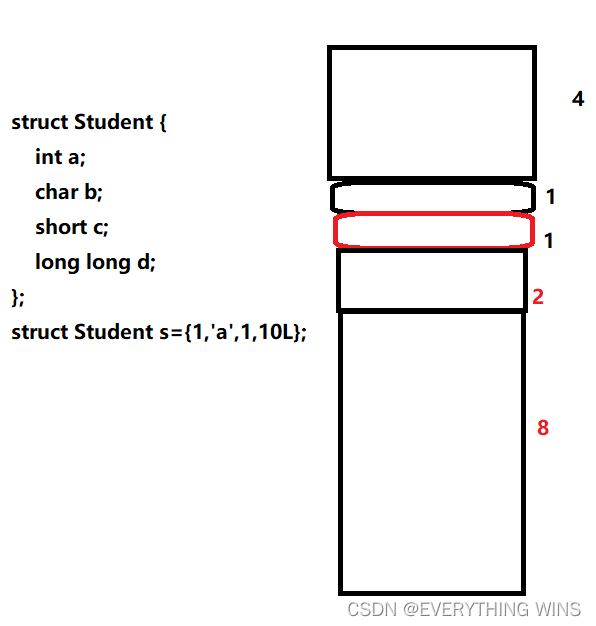文章目录
结构体的设计问题
定义一个结构体类型的数组
#include<stdio.h>
struct Student{
const char* name;
int age;
int score;
};
int main() {
//定义结构体变量
struct Student stu1 = { "zs",10,100 };
struct Student stu2;
stu2 = { "ls",12,98 };
//通过结构体变量来进行成员的访问 .(点,成员访问符)
printf("%s\n", stu1.name);
//定义一个结构体类型的数组,赋值,数组打印:第...个学生姓名,年龄,成绩
struct Student arr[] = { {"zs",10,100},{"ls",12,98} };
int len = sizeof(arr) / sizeof(arr[0]);
for (int i = 0; i < len; i++) {
printf("第%d个学生:姓名:%s 年龄:%d\n", i + 1, arr[i].name, arr[i].age);
}
struct Student brr[] = { stu1,stu2,{"wmz",9,89} };//上面已经定义过 stu1,stu2,可直接引用到数组中
for (int i = 0; i < len; i++) {
printf("第%d个学生:姓名:%s 年龄:%d\n", i + 1, arr[i].name, arr[i].age);
}
}

利用 typedef 对 结构体进行重命名
利用 typedef 对 struct Student(结构体) 进行重命名,使得C与C++不需修改都可使用
分开写为:
struct Student{
const char* name;
int age;
int score;
};
typedef struct Student Student;
也可合起来写:
typedef struct Student{
const char* name;
int age;
int score;
}Student;
int main(){
Student s={"zs",10,100};
}
结构体和指针的结合
结构体指针定义,解引用,指向符
typedef struct Student {
const char* name;
int age;
int score;
}Student;
int main() {
Student s = { "zs",10,100 };
Student* ptr = &s;
printf("%s\n", (*ptr).name); //1
printf("%d\n", ptr -> age); //2 1,2效果相同 ->指向符(具有解引用的功能)
}

解引用的优先级比点结构体体访问符的优先级低,所以要给解引用加上括号,也可通过 指向符 来进行解引用
指针 结构体 typedef 三者结合
第一种,分开定义
struct Student {
const char* name;
int age;
int score;
};
typedef struct Student Student;
typedef struct Student* Pstu;
int main() {
Student s = { "zs",10,100 };
Pstu ptr = &s;
printf("%s\n", (*ptr).name);
printf("%d\n", ptr->age);
}
第二种,合起来定义
typedef struct Student {
const char* name;
int age;
int score;
}Student,*Pstu;
int main() {
Student s = { "zs",10,100 };
Pstu ptr = &s;
printf("%s\n", (*ptr).name);
printf("%d\n", ptr -> age);
}
结构体的使用
按照学生成绩对学生数组进行冒泡排序(降序)
若成绩相同,按照姓名进行冒泡排序(降序)
typedef struct Student {
const char* name;
int age;
int score;
}Student, * Pstu;
typedef Student Elemtype;
void Swap(Elemtype* a, Elemtype* b) {
Elemtype t = *b;
*b = *a;
*a = t;
}
//冒泡
void SBubbleSort(Elemtype* arr, int len) {
for (int i = 0; i < len; i++) {
int flag = 0;
for (int j = 0; j < len - 1 - i; j++) {
if (arr[j].score < arr[j + 1].score) {
Swap(&arr[j], &arr[j + 1]);
flag = 1;
}
else if (arr[j].score == arr[j + 1].score) {
if (strcmp(arr[j].name, arr[j + 1].name) < 0) {
Swap(&arr[j], &arr[j + 1]);
}
}
}
if (!flag) {
break;
}
}
}
int main() {
Student arr[] = { {"zs",10,100},{"ls",9,100} ,{"wmz",10,98} };
int len = sizeof(arr) / sizeof(arr[0]);
SBubbleSort(arr, len);
for (int s = 0; s < len; s++) {
printf("第%d名:姓名:%s 年龄:%d 成绩:%d\n", s+1, arr[s].name,arr[s].age,arr[s].score);
}
return 0;
}

结构体大小
1.地址访问:CPU 内存读写不是按照1字节1字节读取,我们可以设定根据 2,4,8 的倍数的字节块读取内存。
2.平台读取地址,偶数地址读取
3.不同平台内存对齐方式不同
占用内存空间问题
在不考虑内存对齐的情况下:
struct Student{
const char name[10];
int age;
int score;
};
struct Stdent stu = { "zs",10,100 };

上述代码stu占用十八个字节
struct Student{
const char* name;
int age;
int score;
};
struct Stdent stu = { "zs",10,100 };

上述代码*const char name;占用四个字节(根据平台而异),所以stu占用十二个字节
内存对齐的规则
注:MIN表示两者中最小的一个
1)变量首地址,必须是 MIN(结构体最大基本类型数据,指定对齐方式)所占字节的整数倍
2)每个成员变量相对于结构体首地址的偏移量,都是 MIN(该成员基本数据类型,指定对齐方式)所占字节的整数倍
3)结构体总大小为MIN(结构体最大数据类型(结构体内有嵌套结构体,应为所有结构体的最大数据类型),指定对齐方式)所占字节对的整数倍
4)vs 上默认对齐方式为 8 个字节,Linux上默认对齐方式为 4 个字节
例如:
struct Student {
int a;
char b;
short c;
long long d;
};
struct Student s = { 1,'a',1,10L };
int main() {
printf("%d\n", sizeof(Student));
}


如图,该结构体占 4+1+1+2+8=16 个字节
利用 #pragma pack() 来指定内存的对齐方式
#pragma pack(字节) 对齐方式开始 预处理指令
#pragma pack() 对齐方式结束 预处理指令
例如:
#pragma pack(8)
struct Student {
int a; //4
char b; //1+1
short c; //2
long long d; //8
char e; //1+7
};
#pragma pack()
int main() {
printf("%d\n", sizeof(Student));
}

#pragma pack(4)
struct Student {
int a; //4
char b; //1+1
short c; //2
long long d; //8
char e; //1+3
};
#pragma pack()
int main() {
printf("%d\n", sizeof(Student));
}

struct A {
long long a;//8
short b;//2+6
};
struct B {
struct A add;//16
int c;//4+4
};
#pragma pack()
int main() {
printf("%d\n", sizeof(B));
}

结构体与动态内存的结合
#include<stdio.h>
#include<assert.h>
#include<stdlib.h>
#include<string.h>
typedef struct Student {
const char* name;
int age;
}Stu;
int main() {
Stu s = { "zd",12 };
Stu* p = (Stu*)malloc(sizeof(Stu));
assert(p != NULL);
memset(p, 0, sizeof(Stu));
printf("%s\n", p->name);
free(p);
p = NULL;
return 0;
}






















 1万+
1万+











 被折叠的 条评论
为什么被折叠?
被折叠的 条评论
为什么被折叠?








